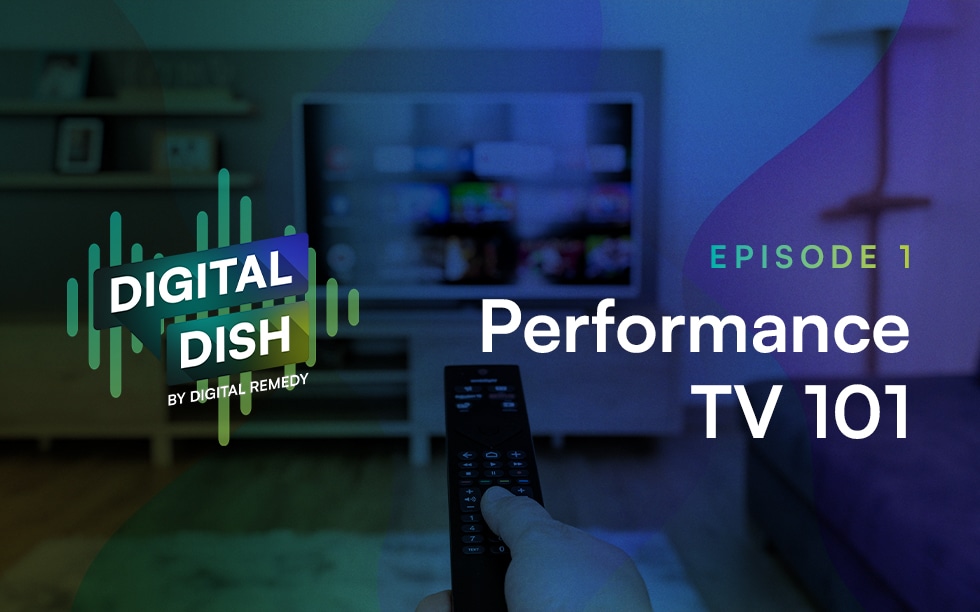Nov 30, 2022
The Digital Remedy Team is excited to announce the launch of our “Digital Dish” series, where we’ll tap into industry experts to share the latest news on all things ad tech, plus actionable insights for advertisers and agencies! We’re kicking things off with the team discussing #PerformanceTV, including why it’s such a hot topic, industry challenges,…

The Digital Remedy Team is excited to announce the launch of our “Digital Dish” series, where we’ll tap into industry experts to share the latest news on all things ad tech, plus actionable insights for advertisers and agencies! We’re kicking things off with the team discussing #PerformanceTV, including why it’s such a hot topic, industry challenges, and some of the solutions that can be considered when it comes to getting the most from Performance TV.
Prefer to read? Here’s the transcript: We dish on all things ad tech. We’re kicking off with performance TV as this is a hot topic in the industry. Performance has traditionally been associated with search, display and social. However, these media are producing diminishing returns as consumer attention becomes more divided and advertisers continue to saturate those channels, we now live in a world where performance traditionally associated with pure play digital channels can now actually be achieved on TV. This is accomplished through the right data, insights that can tell you how your partners are performing, and real-time optimization opportunities. Performance TV answers questions like what is resonating best with what audiences, what creatives work best, what event would cause a customer to convert. And in this video, we’ll look at what we’ve seen in the industry, what the industry challenges, and some of the solutions a brand or agency can consider when it comes to getting the most from performance TV. What we’ve seen in traditional TV advertising has been focused on casting a wide net to capture audience for advertisers. As a result, advertisers have traditionally looked to reach and frequency as the key metrics for campaign success. But with the growth in digital advertising, advertisers saw an opportunity to use a new medium to deliver advertising that could be closely tied to performance. So, over the last few years, we’ve seen a significant growth in CTV and the need to tie that exposure to an actual response. With linear, we have an inability in real time to evaluate, perform. Performance can be defined as being able to measure an outcome, whether that be website visits, online purchases, app downloads, and more. That’s how performance marketing for TV was born. And as performance TV has a solution that evolves, so will the industry and marketers now have the opportunity to boost KPIs and drive their media investment efficiently. The industry challenge that a lot of advertisers have right now is twofold. You have the linear side of the house that’s all about premium, nonskippable, 100% in-view inventory, but they’re lacking the data metrics coming back to be able to validate, yes or no, if this is the right medium mix for them. On the digital side of the house, you’re getting all those validating metrics back, but on the front side, you’re getting a lot of low-impact advertising that may or may not have a true impact on the bottom line. So where performance TV comes into play is it’s blending the two of those worlds together and eliminating those cons. You still get your non-skippable premium 100% in-view TV inventory, and you’re getting those attributable data metrics down funnel to validate, yes or no, if this is the right place for you. So that’s really where we see performance TV being the best of both worlds. So as this whole streaming ecosystem has emerged so too has the ad space surrounding it. What we’re talking about here is combining the best things about digital with the best things about linear television. Digitally we’re used to being able to target granular audiences, target certain geographies in market segments, particular types of inventory. All of that stuff is also available within the streaming advertising ecosystem. With linear, we’re talking about really high-impact placements on, you know, TV on your wall full screen, full episode player. And again, with streaming, all of that is available too. That’s the default format. So with the two of these things combined, we have really enhanced targeting, really enhanced formats, and then the last part of this ecosystem is measurement. What we’re talking about here is the instance where you’re watching a show on Hulu, you see an advertisement for a brand, and then you take some real-world action that’s relevant to that brand. So you go to the brand’s website, you check out, or you go to a store. These are the types of things that performance CTV vendors and advertisers are starting to be able to do and accomplish as they’re starting to explore the streaming ecosystem. So you get really enhanced measurement capabilities on this ecosystem as well as the ability to do things like incrementality analysis, the ability to wrap in brand lift, the ability to get insights below the aggregate, so seeing which streamers, which times of day which audiences, which creatives are really driving those actions that matter the most to you and your brand. Interested in learning more? Read our recent Trends & Insights report or speak to a team member! Stay updated on more insights by following us on LinkedIn, Twitter, and Instagram.
Related Posts

In today’s ever-evolving digital landscape, effective marketing strategies demand innovation and precision. YouTube TV advertising has emerged as a.

The consumer packaged goods (CPG) industry is elbowing through a tight market. Between pressing supply chain challenges, shifting shopper.

The age-old maxim of “think globally, act locally” isn’t just embraced by marketers for local mom-and-pop businesses. Today, massive.